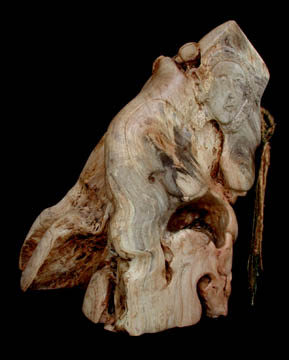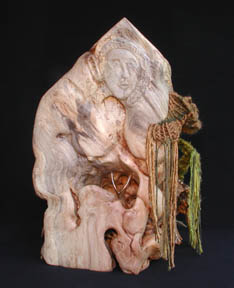| Odyssey | Spirit Caves | Mom's Bones | Tikkun Olam | Weaving | Totems |
Washer at the Ford (Celtic Myth & Art)
Burden baskets for souls to be cleansed before crossing the river to the Other World |
The inner sanctum of the Sacred Feminine |
Golden Wish Bone Within |
17"h x 12"w x 16"d
Ficus root, varnish, cast gold wishbone, wire, fiber.
|
This figure represents a Celtic goddess who washes the souls of the Dead so they can ford the river to the Underworld in ritual purity. She is reminiscent of other Celtic crones, the sexualized Sheela-na-gig, incorporated into many Celtic convents, and the mythological topography, of the breast-shaped hills in County Kerry, Ireland, called the Paps of Anu, and believed to represent the connection of the earthly and the sacred. Curious for me as an artist is the" co-incidence" in this piece, of the façade (the West-Front) of an old abbey and the "hood" of this ancient crone goddess, a sacred conjunction of cathedral, goddess, and the experienced body of an aging woman. The Washer at the Ford was created from one section of a ficus root of which the facing section became the sculpture Triple Goddess, also in this series. The ancient Celtic figure, the Washer at the Ford, came to my attention in a class with Ceile De leader Fionn Tulach. This piece evolved in response both to the form of the ficus root and Fionn's teaching. The asymmetry of the section of root on one side was compensated for by incorporating "burden baskets" (a Native American concept), which I created with wire as armatures and various yarns, and which are filled with small sculpted hearts -- as if the task of the Washer at the Ford is to cleanse the hearts of the dying. Recently at a seminar given by Partners for Youth Empowerment (PYE), I learned from the young participants a chant that touched me deeply and which I could imagine being sung by a dying person, as the Washer waited at the Ford. "All I want / is for you / to remember me / loving you." Read my short story about personal experience and the Hag, The Sword in the Stone, first published in Reiki Magazine International. When I first began sculpting these larger wood pieces from the roots of trees, I mostly "uncovered" what was hidden beneath the encasing mud and rocks. After extensive cleaning and trimming away smaller rootlets, I felt my task was to reveal the bolder forms that my excavations exposed. For the first several sculptures, I found myself hesitant to "penetrate" the wood with the sharp tools that actually cut into it. It took several months of intense interaction with the wood for me to develop what I now consider a reciprocity -- a relationship of invitation and response between the wood and my own creativity. The wood invites me to reveal what is already within the grain structure, cracks, tones, and vitality. Then I respond to that initial form from my own knowing, offering certain meanings and interpretations, and adding my own sense of form and purpose as I work with what has been revealed.
|


